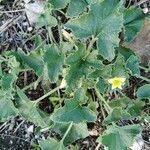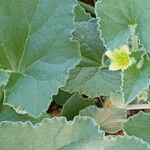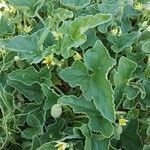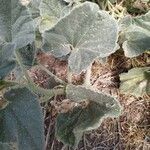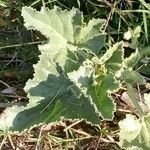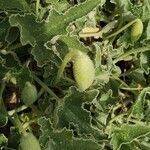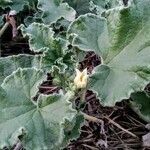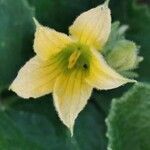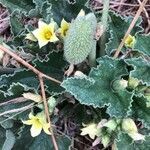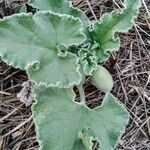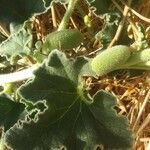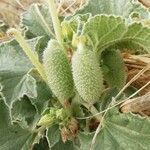Roots elongate, robust. Stem ca. 1.5 m, scabrous. Petiole somewhat robust, 5-15 cm, densely setose; leaf blade ovate-oblong or hastate, 8-20 × 6-15 cm, scabrous, abaxially white pubescent, adaxially white setose, margin sinuous or slightly divided, apex slightly obtuse; sinus semicircular, sometimes truncate. Male flowers in a raceme; peduncle densely yellow-brown pubescent and setose; pedicels filiform, 1-3 cm; calyx segments lanceolate, 5-6 × 1.2-2 mm, densely pubescent and hispid; corolla yellow, ca. 3 cm in diam.; segments ovate-oblong; filaments ca. 3 mm, base villous. Fruit oblong or ovoid-oblong, 4-5 × 1.5-2.5 cm, scabrous, yellow-brown hispid, both ends obtuse. Seeds ca. 4 mm.
Stems 15–80 cm. Leaves long-petiolate; blade bicolor, 4–10 cm, fleshy, abaxially lighter because of densely hirsute to hirsutulous vestiture. Staminate flowers 1 or 2–8 in racemes 5–35 cm. Pistillate flowers: peduncles erect, sharply recurved-nodding at apex so that mature fruit is pendent, 1–8 cm. Corollas (14–)18–20 mm diam.; petals 8–16 mm (staminate) or 6–14 mm (pistillate). Fruits 4–5.5 cm, pendulous on peduncles 1–8 cm. Seeds 4–5 mm. 2n = 18, 24.
Leaves with lamina 8–20 cm long, 6–15 cm wide, scabrid, white tomentose beneath; petiole 5–15 cm long. Male racemes on peduncles 5–15 cm long; pedicels 1–3 cm long; hypanthium 2–3 mm long; calyx-lobes 3–5 mm long; corolla-lobes 8–12 mm long, yellow. Female flowers on pedicels 5–30 mm long; ovary 6–15 mm long. Fruit 30–45 mm long, 15–20 mm diam.; pedicel to 18 cm long. Seeds 5 mm long, dark brown.
A creeping herb. The roots are robust. It can re-grow from the roots. The leaf stalk is 5-15 cm long. The leaves are heart shaped. They are 8-20 cm long by 6-15 cm wide. There are white hairs underneath. The male flowers occur in a group and female flowers occur singly. They are yellow. The fruit is oval or oblong and 4-5 cm long by 2-3 cm wide.
